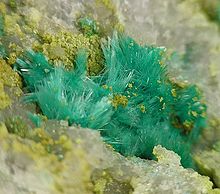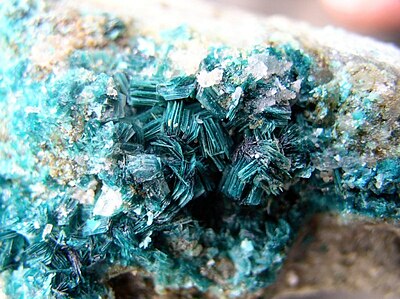Devillin
| Devillin | |
|---|---|
| Rosette-shaped devillin from Raslavice in Slovakia | |
| General and classification | |
| chemical formula | Cu 4 Ca [(OH) 6 | (SO 4 ) 2 ] • 3H 2 O |
|
Mineral class (and possibly department) |
Sulfates (and relatives) |
|
System no. to Strunz and to Dana |
07.DD.30 ( 8th edition : VI / D.19) 31.06.01.01 |
| Crystallographic Data | |
| Crystal system | monoclinic |
| Crystal class ; symbol | monoclinic prismatic; 2 / m |
| Space group | P 2 1 / c (No. 14) |
| Lattice parameters |
a = 20.87 Å ; b = 6.14 Å; c = 22.19 Å β = 102.7 ° |
| Formula units | Z = 8 |
| Twinning | after {010} |
| Physical Properties | |
| Mohs hardness | 2.5 |
| Density (g / cm 3 ) | measured: 3.13; calculated: 3.084 |
| Cleavage | completely after {001} |
| Break ; Tenacity | brittle |
| colour | blue-green, dark emerald green to patina green |
| Line color | white to light green |
| transparency | transparent to translucent |
| shine | Glass luster, pearlescent luster on the gap surfaces |
| Crystal optics | |
| Refractive indices |
n α = 1.585 n β = 1.649 n γ = 1.660 |
| Birefringence | δ = 0.075 |
| Optical character | biaxial negative |
| Axis angle | 2V = measured: 37 to 41 °; calculated: 42 ° |
| Pleochroism | visible: X = light green; Y = blue green; Z = dark green |
| Other properties | |
| Chemical behavior | insoluble in water and dilute H 2 SO 4 , easily soluble in dilute HNO 3 |
Devillin , also known as Devillit , Herrengrundit , Lyellit or Úrvölgyit , is a rather seldom occurring mineral from the mineral class of " sulfates ( and relatives )". It crystallizes in the monoclinic crystal system with the chemical composition Cu 4 Ca [(OH) 6 | (SO 4 ) 2 ] • 3H 2 O and develops mostly needle-like or thin tabular crystals with a pseudo-hexagonal habit in rosette-shaped or tufted mineral aggregates , but also crusty coatings from blue-green, dark emerald green to patina green color with light green streak color .
The undamaged surfaces of the transparent to translucent crystals have a glass-like sheen , whereas the cleavage surfaces are more pearlescent. With a Mohs hardness of around 2.5, Devillin lies between the reference minerals gypsum (2) and calcite (3).
Etymology and history
Devillin was first discovered in the English county of Cornwall and described in 1864 by MF Pisani, who named the mineral after the French chemist Henri Étienne Sainte-Claire Deville (1818-1881).
Devillin got his synonyms Herrengrundit and Úrvölgyit due to rich mineral finds and descriptions from the Slovak region Špania Dolina , in German "Herrengrund" or Hungarian "Úrvölgy".
classification
In the now outdated, but still in use 8th edition of the mineral classification according to Strunz , the devillin belonged to the mineral class of "sulfates, selenates , tellurates , chromates , molybdates and tungstates " and there to the department of "water-containing sulfates with foreign anions ", where it belongs together formed an independent group with Arzrunite , Campigliaite , Lautenthalite , Niedermayrit , Orthoserpierite , Serpierite and Tatarskite .
The 9th edition of Strunz's mineral systematics , which has been in effect since 2001 and is used by the International Mineralogical Association (IMA), also assigns the Devillin to the class of "sulfates (selenates, tellurates, chromates, molybdates and wolframates)" and there in the department of "Sulphates (selenates, etc.) with additional anions, with H 2 O". However, this section is further subdivided according to the size of the cations involved and the crystal structure, so that the mineral is classified according to its composition in the sub-section “with medium-sized cations; Layers of edge-linked octahedra “can be found where it forms the unnamed group 7.DD.30 together with campigliaite, Lautenthalite, Niedermayrite, Orthoserpierite and Serpierite .
The systematics of minerals according to Dana , which is mainly used in the English-speaking world , assigns the devillin to the class of "sulfates, chromates and molybdates" and there to the category of "water-containing sulfates with hydroxyl or halogen". Here it can be found together with Lautenthalite in the unnamed group 06/31/01 within the subdivision of " Water-containing sulfates with hydroxyl or halogen with (A + B 2+ ) 5 (XO 4 ) 2 Z q × x (H 2 O) " .
Crystal structure
Devillin crystallizes monoclinically in the space group P 2 1 / c (space group no. 14) with the lattice parameters a = 20.87 Å ; b = 6.14 Å; c = 22.19 Å and β = 102.7 ° and eight formula units per unit cell .
Education and Locations

Devillin is a secondary mineral found in the oxidation zone of copper sulfides. Since it is produced by oxidation with atmospheric oxygen, it can also be formed on heaps as a secondary mineral. Accompanying minerals include antlerite , azurite , brochantite , gypsum , langite , linarite , malachite and posnyakite .
Devillin is one of the seldom occurring minerals, so it can be partly abundant at different locations, but is generally not very widespread. So far (as of 2011) around 300 sites have been registered. In addition to its type locality in Cornwall, the mineral occurred in the United Kingdom (Great Britain) in the regions of Cumbria , Devon , Shropshire and Staffordshire in England; at Wanlockhead in Scotland and in the Welsh regions of Ceredigion , Gwynedd and Powys .
The Špania Dolina ( Herrengrund , Úrvölgy ) region in Slovakia is worth mentioning due to the exceptional devillin finds , from which the best examples of crystal rosettes with a diameter of up to one centimeter come from.
In Germany, Devillin has so far mainly been found in the Black Forest in Baden-Württemberg, in the Bavarian Fichtel Mountains and Upper Palatinate Forest , near Frankfurt and Richelsdorf in Hesse, in the Harz from Lower Saxony to Saxony-Anhalt, in the Niederbergisches Land , Sauerland and Siegerland in North Rhine-Westphalia, in the Eifel and Lahntal , on the Hunsrück , near Imsbach and Rheinbreitbach in Rhineland-Palatinate, in the Ore Mountains and Upper Lusatia in Saxony, on Helgoland in Schleswig-Holstein as well as near Greiz , Ilfeld and the former dump near Ronneburg in Thuringia.
Devillin could also be detected in rock samples from the Mid-Atlantic Ridge .
Other sites are in Belgium, Canada, Chile, France, Greece, Ireland, Italy, Japan, Kazakhstan, the Democratic Republic of the Congo, Morocco, Mexico, Namibia, New Zealand, Norway, Austria, Poland, Portugal, Sweden, Switzerland, Spain, the Czech Republic, Hungary and the United States of America (USA).
Devillin is a mineral with a very pronounced anisotropy , which means that its properties are different in the three main axes.
See also
literature
- Krause, W. & Täuber, H. (1992): On the state of knowledge of the minerals serpierite, orthoserpierite and devillin. Exposure 43, 1-25.
- Maskelyne (1864) Chemical News and Journal of Industrial Science, London: 10: 263 (as Lyellite)
- Brezina (1879) Journal for Crystallography, Mineralogy and Petrography, Leipzig: 3: 359 (as Herrengrundite)
- Szabó (1879) Mineralogical and Petrographic Communications, Vienna: 2: 311 (as Urvölgyite)
- Szabó (1879) Lit. Ber. Hungary: 3: 510 (as Urvölgyite)
- Brezina (1887) Journal for Crystallography, Mineralogy and Petrography, Leipzig: 13: 670 (as Herrengrundite)
- Goldschmidt, V. (1890) Index of the crystal forms of minerals. 3 volumes: vol. 2, 542pp .: 150
- Goldschmidt, V. (1918) Atlas of the crystal forms. 9 volumes, atlas, and text: vol. 4: 131
- Palache, C., Berman, H., & Frondel, C. (1951), The System of Mineralogy of James Dwight Dana and Edward Salisbury Dana, Yale University 1837-1892, Volume II. John Wiley and Sons, Inc., New York, 7th edition, revised and enlarged, 1124 pp .: 591-592
- C. Sabelli and PF Zanazzi (1972): The crystal structure of devillite. Acta Crystallogr., B28, 1182-1189
Web links
Individual evidence
- ↑ a b c d e Hugo Strunz , Ernest H. Nickel: Strunz Mineralogical Tables . 9th edition. E. Schweizerbart'sche Verlagbuchhandlung (Nägele and Obermiller), Stuttgart 2001, ISBN 3-510-65188-X , p. 402 .
- ↑ Webmineral - Devilline (English)
- ↑ a b c Handbook of Mineralogy - Devilline (English, PDF 68.4 kB)
- ↑ a b c d Devilline at mindat.org (engl.)
- ↑ Mineral Atlas: Devillin (Wiki)
- ↑ MF Pisani: Sur une nouvelle espece minérale du Cornouailles, la devilline , in: Comptes Rendus Hebdomadaires des Séances de l'Académie des Sciences , 59, pp. 813-814 (French, PDF 329 kB)
- ↑ Petr Korbel, Milan Novák: Mineral Encyclopedia . Nebel Verlag GmbH, Eggolsheim 2002, ISBN 3-89555-076-0 , p. 149 ( Dörfler Natur ).
- ↑ Mindat - Localities for Devil Line

